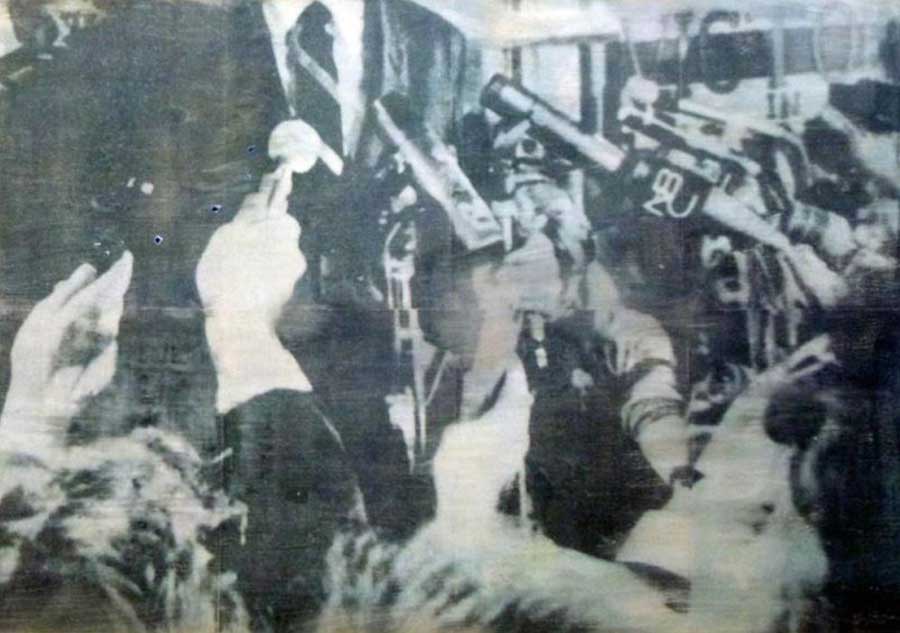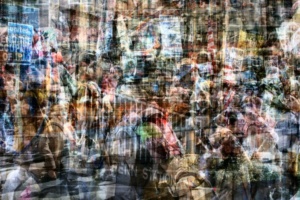
News cycles, before people discussed them as “news cycles,” used to have an explicit rhythm, dictated by how often news-media products could be produced and distributed. There was a daily newspaper and perhaps some late editions, news radio’s traffic and transit churn, and the set schedule of TV news broadcasts. Occasionally, regular programming would be interrupted with “breaking news,” as when the soap operas were pre-empted to announce that Reagan had been shot, or when O.J. Simpson’s Bronco flight bumped the NBA finals into a small split screen.
But ordinarily there was only so much news that could fit. This limitation wasn’t a drawback but what made a definition of newsworthiness possible: If something made the cut, based on the editorial judgment of a small set of media professionals, it became news. If it didn’t, it was just another more or less quirky aspect of the vast and mostly unremarkable tapestry of everyday life.
This left a lot off the table for media companies. But what if news and everyday life could be collapsed? What if everyday life could consist of continual interaction with media? News had always been manufactured to fit and support the existing spaces for it, as Daniel Boorstin had argued in The Image in 1962, so why not use technology to expand the space as much as possible, create or fulfill the desire for ever more engaging incident?
Then came the perpetual news crawl, in the wake of the 2000 election, which returned on 9/11 and never went away. We started to talk explicitly about news cycles when their seemingly inherent logic began to break down, when news was produced on a continual 24-hour basis and news producers became not a small set of editors and journalists and TV producers but anyone who could garner sufficient attention amid the profusion of media distribution tools the internet afforded. As more and more information was being disseminated, we wanted news cycles to really exist; we talked about “information overload” as if the limited range of news the media once could supply was the naturally appropriate amount.
“Information overload” made sense as a frame when we still had an intuitive sense of how big a newspaper should be, or how many stories fit into an hour. None of that is relevant anymore. “News cycles” are nostalgia fodder. Now we have “news feeds” that populate with stories just as fast as we can scroll. The limited spaces in which a shared sense of the news was constructed have become infinite personalized expanses. Our information problem has become “too much news” and “never enough news” at the same time.
We are just coming to terms with how this affects the political function of the press, which in a democracy, at least theoretically, is supposed to supply a common set of minimally biased facts to make collective decision-making possible. Racism, sexism, and capitalism have always distorted the “reality” represented in the American media, but for better or worse, this “reality” could once be understood as a singular, tangible thing. Now that sense of a shared reality has been widely destroyed, and the press has shifted to a function that seems to better harmonize with how media technology has changed: to provide audiences with perpetual distraction.
In the first of what will be weekly packages of themed essays at Real Life, we are examining the idea of “too much news” — the logic of accelerating news cycles to the vanishing point and saturating social space with current events commentary — and the ways in which “feeling informed” is becoming more palpably affective. Donald Trump is among the first American political figures to fully emerge from this shift. As Nathan Jurgenson writes in “Breaking News,” the first of our essays this week, Trump’s rise has been a triumph for the news business: “From a business perspective, the Trump election was a resounding success: There is more news to cover, always bigger, with higher ratings, and a president who abides by such ratings demands.” From this perspective, Trump’s alleged “war on the press” — which has more in common with pro wresting than book banning — is a victory for both sides.
Frequent press updates on Trump may appear a form of resistance but do little toward unseating him or changing his agenda. They may serve instead as a gripping, peculiarly comforting reminder of both our political powerlessness and our compensatory consumer sovereignty. We can’t do anything except choose what to read next, and through that, choose how to feel. Elisa Gabbert, in “True Crime,” revisits Janet Malcolm’s critique of journalistic duplicity and complicity in The Journalist and the Murderer and links it to our complicated relationship with news as narrative in the Trump era. Malcolm argues that attention from journalists makes their subjects become gullible and attention-thirsty; Gabbert likens that to our own exposure to journalists on Twitter: “Though most of us won’t get the chance to play the subject, following a journalist creates a kind of false intimacy. It encourages that same blind trust, which the journalist is then poised to exploit. Like the relationship between journalist and subject, the relationship between newsmaker and news consumer is mutually parasitic.”
Navneet Alang, in “Emotional Overdrive,” notes how social media have not only expanded the availability of information and our access to journalists but have also made news circulation inseparable from the circulation of personal feelings. “When news becomes a flood of not just data but affect, there is more at stake than frustration,” he writes. “Information overload” becomes “affect overload.”
The way we consume news has become more closely bound with a sense of our demonstrable identity. We feel a need to be informed not to be responsible citizens but to stop the sense that who we think we are, and who we think our people are, is slipping away. If nothing else, the continual flow of information is there to remind us that everything is precarious, nothing enduring, and we must keep rearticulating what matters to us as often as possible if we are to hope to be believed. And so the messengers keep arriving, but the news is not good.
Featuring:
“Breaking News,” by Nathan Jurgenson

“True Crime,” by Elisa Gabbert

“Emotional Overdrive,” by Navneet Alang

Thank you for your consideration. Visit us next week for Real Life‘s next installment, CIRCADIAN MEDIA, featuring morning show-ness, mourning routines, and off-peak evangelists.